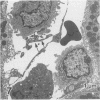Abstract
After administration of bacterial lipopolysaccharide, there is an increase in the number of leucocytes which adhere to the endothelial cell surface of the hepatic vessels and pass through the endothelial layer by comparison with controls. There is also marked endothelial cell damage including intracytoplasmic oedema, increased numbers of autophagic vacuoles and dilatation of the intercellular junction in LPS-treated samples. The presence of immunocytochemical products of leukotriene (LTR) and tumour necrosis factor (TNF) was examined using in both LPS-treated and control samples. Immunoreactions of LTR which were seen in specific granules of neutrophils and monocytes attached to the endothelial cell surface may indicate the onset of endothelial cell damage. Positive immunoreactions of TNF on the endothelial cell surface, seen only in LPS-treated samples, indicate that TNF may enhance the passage of blood cells through the endothelia and also increase the endocytotic activity of the liver parenchymal cells, as revealed by the present marker experiment using horseradish peroxidase. Positive reactions of TNF in lysosomes of the endothelial cells suggest that they are able to produce TNF and transport it to the cell surface.
Full text
PDF
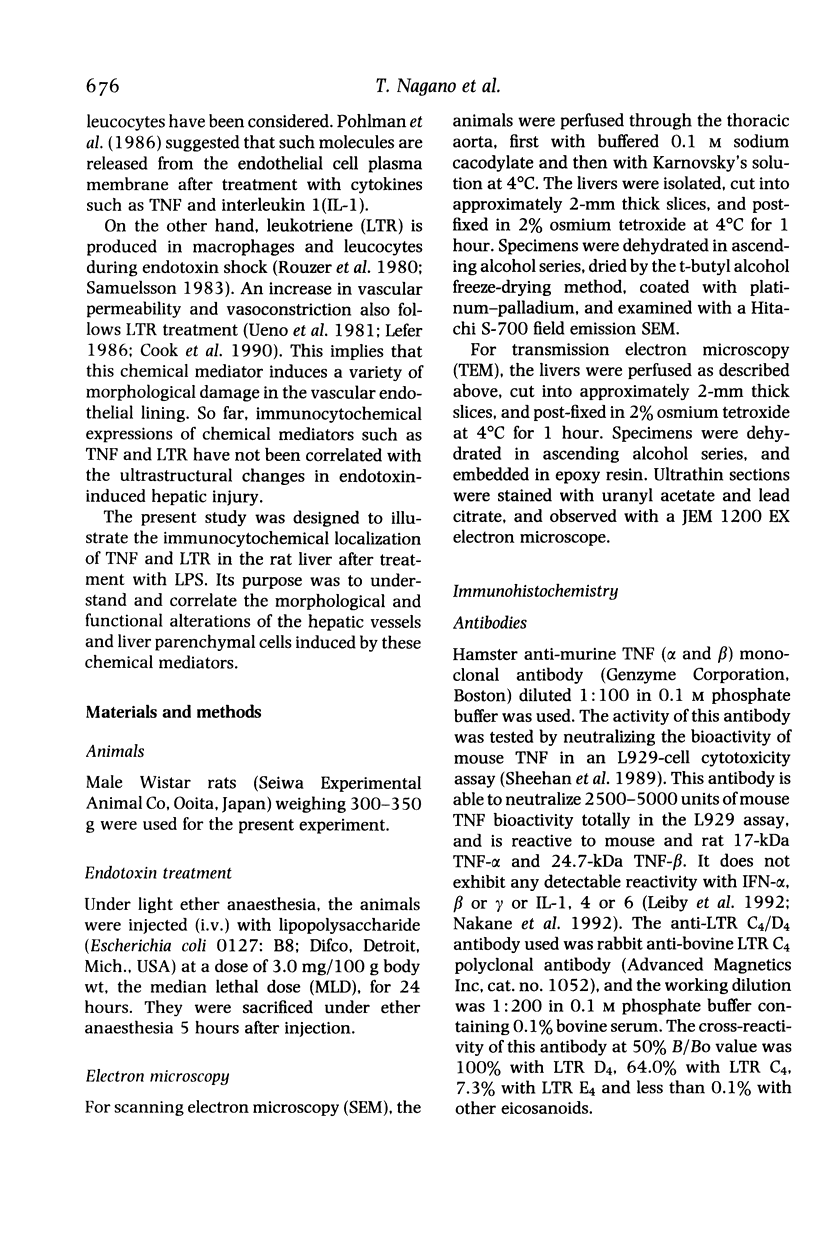
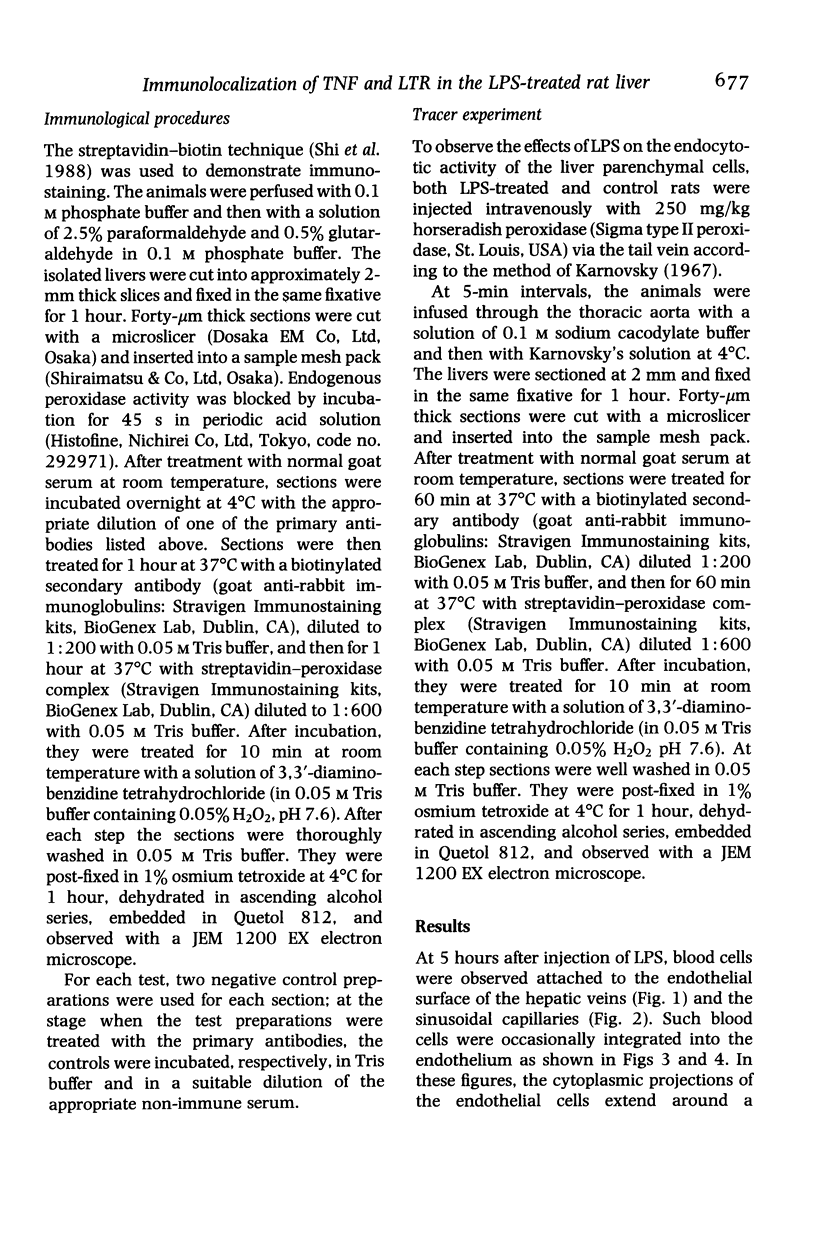


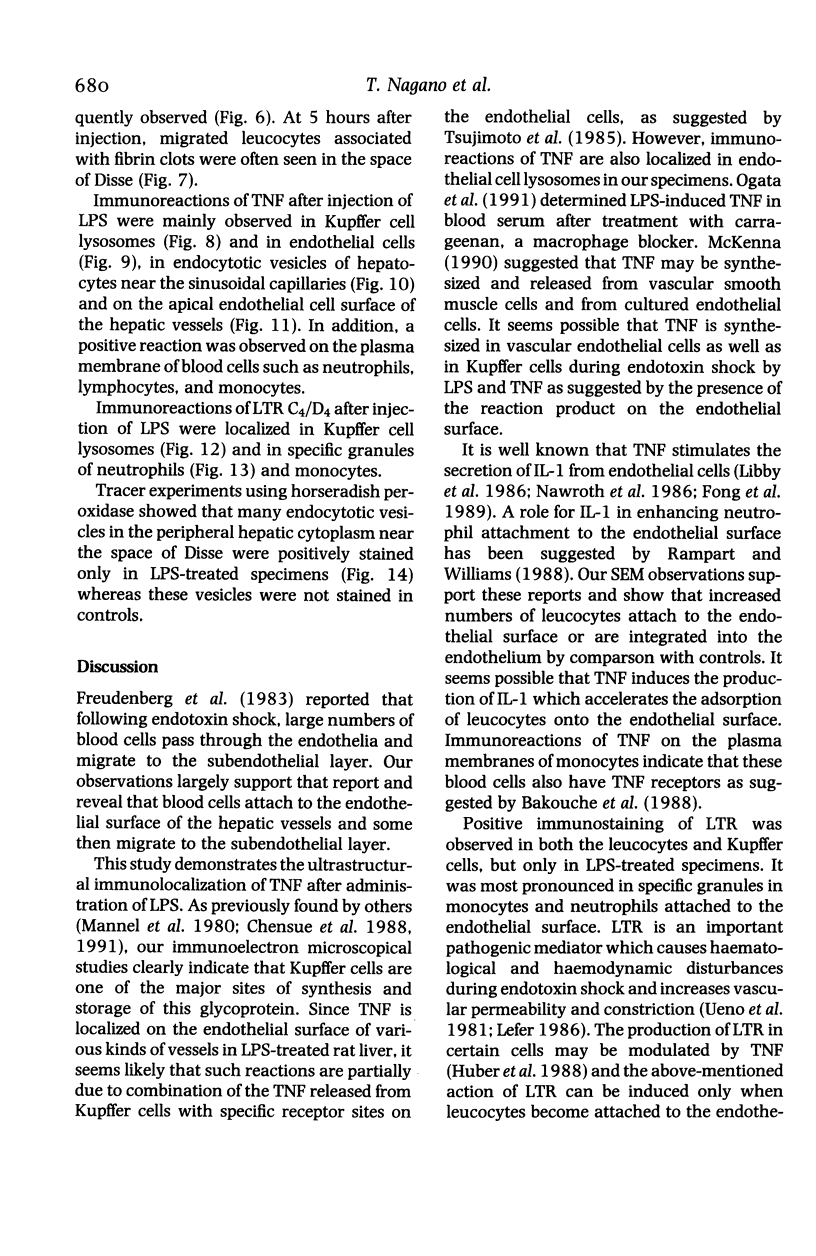
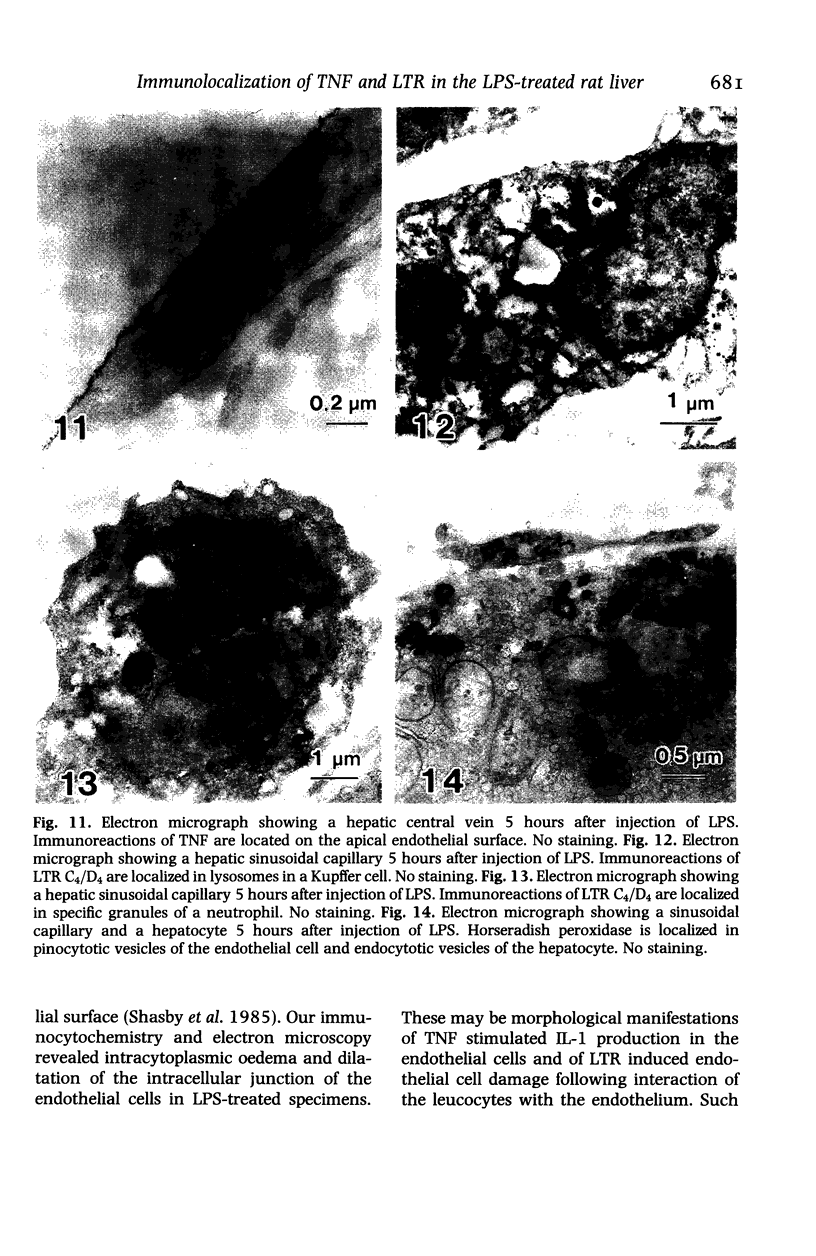


Images in this article
Selected References
These references are in PubMed. This may not be the complete list of references from this article.
- Bakouche O., Ichinose Y., Heicappell R., Fidler I. J., Lachman L. B. Plasma membrane-associated tumor necrosis factor. A non-integral membrane protein possibly bound to its own receptor. J Immunol. 1988 Feb 15;140(4):1142–1147. [PubMed] [Google Scholar]
- Beutler B., Cerami A. Cachectin, cachexia, and shock. Annu Rev Med. 1988;39:75–83. doi: 10.1146/annurev.me.39.020188.000451. [DOI] [PubMed] [Google Scholar]
- Chensue S. W., Remick D. G., Shmyr-Forsch C., Beals T. F., Kunkel S. L. Immunohistochemical demonstration of cytoplasmic and membrane-associated tumor necrosis factor in murine macrophages. Am J Pathol. 1988 Dec;133(3):564–572. [PMC free article] [PubMed] [Google Scholar]
- Chensue S. W., Terebuh P. D., Remick D. G., Scales W. E., Kunkel S. L. In vivo biologic and immunohistochemical analysis of interleukin-1 alpha, beta and tumor necrosis factor during experimental endotoxemia. Kinetics, Kupffer cell expression, and glucocorticoid effects. Am J Pathol. 1991 Feb;138(2):395–402. [PMC free article] [PubMed] [Google Scholar]
- Cook J. A., Li E. J., Spicer K. M., Wise W. C., Halushka P. V. Effect of leukotriene receptor antagonists on vascular permeability during endotoxic shock. Circ Shock. 1990 Nov;32(3):209–218. [PubMed] [Google Scholar]
- Fong Y., Tracey K. J., Moldawer L. L., Hesse D. G., Manogue K. B., Kenney J. S., Lee A. T., Kuo G. C., Allison A. C., Lowry S. F. Antibodies to cachectin/tumor necrosis factor reduce interleukin 1 beta and interleukin 6 appearance during lethal bacteremia. J Exp Med. 1989 Nov 1;170(5):1627–1633. doi: 10.1084/jem.170.5.1627. [DOI] [PMC free article] [PubMed] [Google Scholar]
- Freudenberg N., Freudenberg M. A., Bandara K., Galanos C. Distribution and localization of endotoxin in the reticulo-endothelial system (RES) and in the main vessels of the rat during shock. Pathol Res Pract. 1985 Mar;179(4-5):517–527. doi: 10.1016/S0344-0338(85)80193-X. [DOI] [PubMed] [Google Scholar]
- Huber M., Beutler B., Keppler D. Tumor necrosis factor alpha stimulates leukotriene production in vivo. Eur J Immunol. 1988 Dec;18(12):2085–2088. doi: 10.1002/eji.1830181233. [DOI] [PubMed] [Google Scholar]
- Jones E. A., Summerfield J. A. Functional aspects of hepatic sinusoidal cells. Semin Liver Dis. 1985 May;5(2):157–174. doi: 10.1055/s-2008-1063920. [DOI] [PubMed] [Google Scholar]
- Karnovsky M. J. The ultrastructural basis of capillary permeability studied with peroxidase as a tracer. J Cell Biol. 1967 Oct;35(1):213–236. doi: 10.1083/jcb.35.1.213. [DOI] [PMC free article] [PubMed] [Google Scholar]
- Lefer A. M. Leukotrienes as mediators of ischemia and shock. Biochem Pharmacol. 1986 Jan 15;35(2):123–127. doi: 10.1016/0006-2952(86)90502-2. [DOI] [PubMed] [Google Scholar]
- Leiby D. A., Fortier A. H., Crawford R. M., Schreiber R. D., Nacy C. A. In vivo modulation of the murine immune response to Francisella tularensis LVS by administration of anticytokine antibodies. Infect Immun. 1992 Jan;60(1):84–89. doi: 10.1128/iai.60.1.84-89.1992. [DOI] [PMC free article] [PubMed] [Google Scholar]
- Libby P., Ordovas J. M., Auger K. R., Robbins A. H., Birinyi L. K., Dinarello C. A. Endotoxin and tumor necrosis factor induce interleukin-1 gene expression in adult human vascular endothelial cells. Am J Pathol. 1986 Aug;124(2):179–185. [PMC free article] [PubMed] [Google Scholar]
- McKenna T. M. Prolonged exposure of rat aorta to low levels of endotoxin in vitro results in impaired contractility. Association with vascular cytokine release. J Clin Invest. 1990 Jul;86(1):160–168. doi: 10.1172/JCI114679. [DOI] [PMC free article] [PubMed] [Google Scholar]
- Männel D. N., Moore R. N., Mergenhagen S. E. Macrophages as a source of tumoricidal activity (tumor-necrotizing factor). Infect Immun. 1980 Nov;30(2):523–530. doi: 10.1128/iai.30.2.523-530.1980. [DOI] [PMC free article] [PubMed] [Google Scholar]
- Nakane A., Numata A., Minagawa T. Endogenous tumor necrosis factor, interleukin-6, and gamma interferon levels during Listeria monocytogenes infection in mice. Infect Immun. 1992 Feb;60(2):523–528. doi: 10.1128/iai.60.2.523-528.1992. [DOI] [PMC free article] [PubMed] [Google Scholar]
- Nawroth P. P., Bank I., Handley D., Cassimeris J., Chess L., Stern D. Tumor necrosis factor/cachectin interacts with endothelial cell receptors to induce release of interleukin 1. J Exp Med. 1986 Jun 1;163(6):1363–1375. doi: 10.1084/jem.163.6.1363. [DOI] [PMC free article] [PubMed] [Google Scholar]
- Ogata M., Yoshida S., Kamochi M., Shigematsu A., Mizuguchi Y. Enhancement of lipopolysaccharide-induced tumor necrosis factor production in mice by carrageenan pretreatment. Infect Immun. 1991 Feb;59(2):679–683. doi: 10.1128/iai.59.2.679-683.1991. [DOI] [PMC free article] [PubMed] [Google Scholar]
- Pohlman T. H., Stanness K. A., Beatty P. G., Ochs H. D., Harlan J. M. An endothelial cell surface factor(s) induced in vitro by lipopolysaccharide, interleukin 1, and tumor necrosis factor-alpha increases neutrophil adherence by a CDw18-dependent mechanism. J Immunol. 1986 Jun 15;136(12):4548–4553. [PubMed] [Google Scholar]
- Rampart M., Williams T. J. Evidence that neutrophil accumulation induced by interleukin-1 requires both local protein biosynthesis and neutrophil CD18 antigen expression in vivo. Br J Pharmacol. 1988 Aug;94(4):1143–1148. doi: 10.1111/j.1476-5381.1988.tb11632.x. [DOI] [PMC free article] [PubMed] [Google Scholar]
- Rouzer C. A., Scott W. A., Cohn Z. A., Blackburn P., Manning J. M. Mouse peritoneal macrophages release leukotriene C in response to a phagocytic stimulus. Proc Natl Acad Sci U S A. 1980 Aug;77(8):4928–4932. doi: 10.1073/pnas.77.8.4928. [DOI] [PMC free article] [PubMed] [Google Scholar]
- Samuelsson B. Leukotrienes: mediators of immediate hypersensitivity reactions and inflammation. Science. 1983 May 6;220(4597):568–575. doi: 10.1126/science.6301011. [DOI] [PubMed] [Google Scholar]
- Shasby D. M., Shasby S. S., Peach M. J. Polymorphonuclear leukocyte: arachidonate edema. J Appl Physiol (1985) 1985 Jul;59(1):47–55. doi: 10.1152/jappl.1985.59.1.47. [DOI] [PubMed] [Google Scholar]
- Sheehan K. C., Ruddle N. H., Schreiber R. D. Generation and characterization of hamster monoclonal antibodies that neutralize murine tumor necrosis factors. J Immunol. 1989 Jun 1;142(11):3884–3893. [PubMed] [Google Scholar]
- Shi Z. R., Itzkowitz S. H., Kim Y. S. A comparison of three immunoperoxidase techniques for antigen detection in colorectal carcinoma tissues. J Histochem Cytochem. 1988 Mar;36(3):317–322. doi: 10.1177/36.3.3278057. [DOI] [PubMed] [Google Scholar]
- Tsujimoto M., Yip Y. K., Vilcek J. Tumor necrosis factor: specific binding and internalization in sensitive and resistant cells. Proc Natl Acad Sci U S A. 1985 Nov;82(22):7626–7630. doi: 10.1073/pnas.82.22.7626. [DOI] [PMC free article] [PubMed] [Google Scholar]
- Ueno A., Tanaka K., Katori M., Hayashi M., Arai Y. Species difference in increased vascular permeability by synthetic leukotriene C4 and D4. Prostaglandins. 1981 Apr;21(4):637–648. doi: 10.1016/0090-6980(81)90012-5. [DOI] [PubMed] [Google Scholar]









